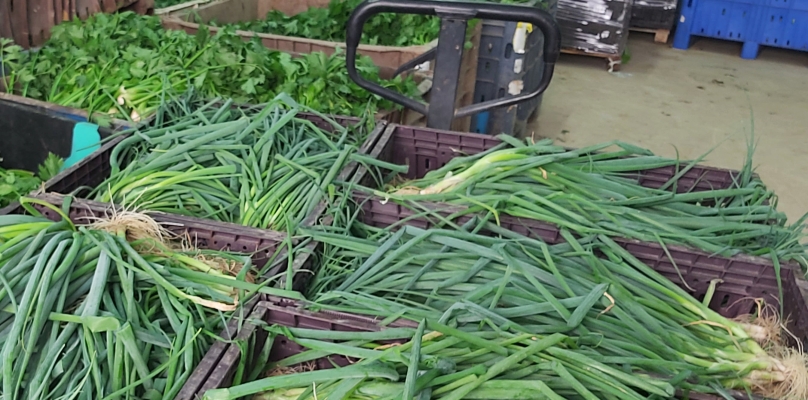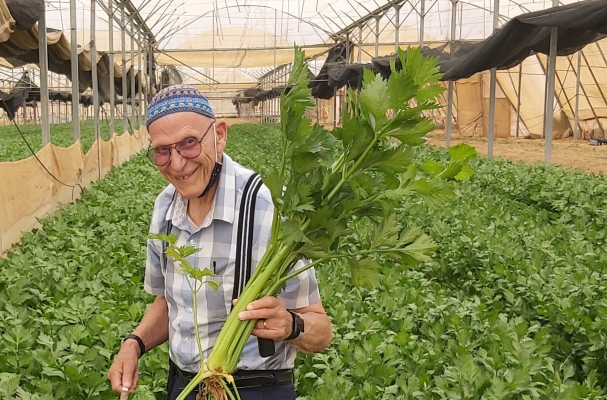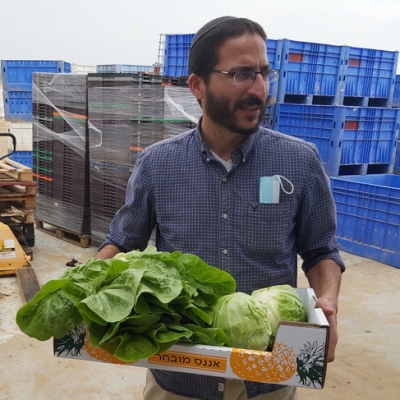A Miracle in the Desert
A person might tend to think that a barren stretch of desert is of no use except for a place for Bedouin and camels. This article will show that this is not true.
While attending the synagogue in Arad, I got acquainted with Amir Monsonego. I was very intrigued to hear about the community where he lives deep in the Negev Desert. The more I learned about this community and their agriculture, the more I wanted to visit and see for myself the miracle that is taking place in the Negev Desert. After more than a year of delay due mainly to the Corona virus, I recently made the drive to the community of Naveh to gather information and take photos.
The communities of Naveh, Bnei Nitzarim, and Slomit are part of the miracle block of communities in the Negev Desert known as Halutza (pioneer), a barren sand-washed area within the triangle area bordering both Gaza and Egypt.
Of the many families who were uprooted from Gaza in 2005, 30 families established religious settlements in 2008, only three years after their expulsion from Gaza. The following quote will show the spirit of the Jews, especially the Jews who were uprooted from all that they had in Gaza. "Jews, I think, are optimistic," Eliyahu Ozan says. "We just look at what happens and we say, yihiyeh tov (it will be okay). To look back is too hard. If I look back I'll be like the wife of Lot [in the book of Genesis], and become salt. So, I only look forward." Today there are more than 2,000 people living in the Halutza communities.
During my visit I interviewed one of the founding leaders of Halutza, Rabbi Eli Adler. Rabbi Adler told me that following their expulsion from the Gush Katif communities in Gaza in 2005, losing their homes, synagogues, schools, gardens, and everything, they were unhappy with the State of Israel and could have given up on their Zionistic dreams. The Jewish people came to Gush Katif for Zionist reasons, and for this reason the people of Gush Katif felt abandoned and decided to step aside and no longer try to develop Israel. It was not simple for the 30 families who decided to come to pioneer, calling the area Halutza because there was nothing there except for a sandy desert. It was also difficult because they had to forget the past and look to the future. "On one hand" Rabbi Adler said, "we had the pain and anger toward the State of Israel, but what brought us to Halutza was our faith in God and knowing that God's plan for the future of the Land is deeper than all of the hurt and the pain we experienced. We are still a part of this miracle and this is stronger than our personal pain and tragedy. So much has happened in the ten years since; a miracle has taken place. Within two or three weeks a decision was made to settle in this desert and start over again. It was a small group who decided to jump into the water, so to speak. At first when trying to get established, we lived in temporary caravans that were moved in. We thought that living in the caravans would be for only eight months before we could move into a regular home, but instead it took five and a half years. If we had known that it would take that long we might not have come at all. Sometimes it is good that God hides some of the difficulties from us."
Rabbi Adler went on to say, "Many families want to come and live here because of the quality of life not found in the large cities. There is suitable housing with parks, synagogues, and schools, as well as quality Jewish life, and an outstanding education program. Parents from all over the country now want to send their boys and girls to study here, because the community has such a good name and because of the agricultural work. Because of the quality of life in Halutza, there is a waiting list of those who want to move here. This a project of faith and long term vision."
Rabbi Adler concluded my interview by encouraging me to keep writing, because it is so important for people to hear positive news and learn of the optimism of the Jewish people.
At the beginning of my visit, Amir welcomed me in his office where he showed me maps of the area and photos that of what the land looked like ten years ago, before the beginning of the Halutza project, and what it looks like now.
Amir told me that mostly young families are moving to the Halutza area to help build the communities. Like Amir and his family, many of these young families live in Halutza because of a program that funds their university education while living in Naveh and being a part of the community.
The Halutza community area has a water park for the children, bicycle paths, and a unique swing area all funded by JNF-USA.
The agricultural fields of crops are irrigated by drip irrigation supplied by means of a water channel funded by JNF-Australia. The source of recycled water (sewage water) is from Gush Dan.
Because of the combination of rich soil, weather, and irrigation, lemons are harvested every three months with the help of workers from Thailand.
The most southern avocado orchard in Israel was planted in 2019 and will begin to be harvested in January 2023.
I was really surprised that they grow pineapples in the desert. The pineapple is considered a tropical fruit. In order to grow pineapples in the Negev, they have to keep the plants in a special agriculture shelter with the right moisture and tropical temperatures. They have created a climate for the pineapple like the climate of Hawaii. I never thought I would see pineapples growing for commercial reasons in the desert.
Amir showed me the healthy stalks of celery growing in a special agriculture shelter, and asked me to harvest a beautiful stalk of celery. It was so special to get my hands into the amazing agriculture and to harvest something. It was a hands-on experience for sure. The farm grows about 60 species of vegetables and crops, of which some are exported to other countries and most are marketed in Israel.
These vegetables are first brought to a shed where they are checked for quality before being shipped. In another building, samples from each crop are tested with a special technical method for detecting any bug or insect problem, in order to guarantee the quality of the produce.
The last thing Amir showed me was the large dairy farm funded by JNF-USA under construction. This project will result in 20 new jobs and 20 new families coming to Halutza as each phase is introduced. As I write, the construction has been completed and 450 cows have been delivered and the number is expected to grow to 650. At full capacity the dairy should produce about nine million liters of milk per year. The dry weather in the Negev Desert is ideal for good quality milk. The first-class milking machines tell how much milk has been given and the temperature and health of the cow. Each cow has a chip on it that feeds the information to a computer. The milk is stored in special large containers and transferred daily to trucks. One of the reasons for this dairy farm is to have another economic anchor, in addition to the crops that are being harvested and grown. It is a green farm with solar panels on the roof, and will also benefit the crops by using recycled water and sewage from the cows. Another phase of the project is to produce dairy products including milk, yogurt, and cheese on site.
Amir gave me a box of vegetables and pineapple to take home with me. What a kind gesture and what an amazing day.











Comments